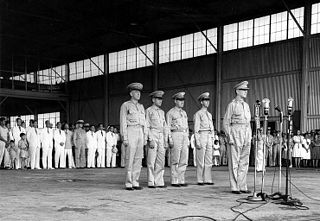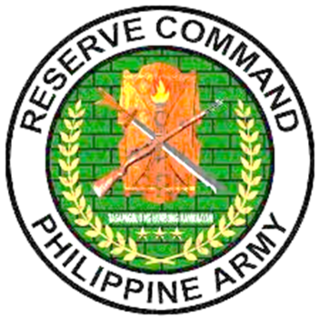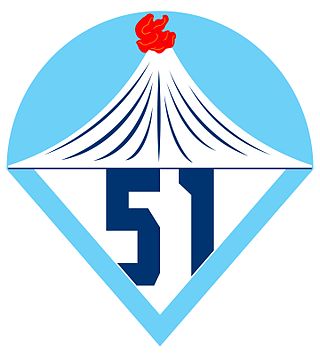
United States Army Forces in the Far East (USAFFE) was a military formation of the United States Army active from 1941 to 1946. The new command's headquarters was created on 26 July 1941, at No. 1, Calle Victoria, Manila, Luzon, the Philippines, with General Douglas MacArthur as commander. The Chief of Staff was Brigadier General Richard K. Sutherland and the Deputy Chief of Staff was Lieutenant Colonel Richard J. Marshall. The core of this command was drawn from the Office of the Military Advisor to the Commonwealth Government of the Philippines.

The 81st Readiness Division ("Wildcat") was a formation of the United States Army originally organized as the 81st Infantry Division during World War I. After World War I, the 81st Division was allotted to the Organized Reserve as a "skeletonized" cadre division. In 1942, the division was reactivated and reorganized as the 81st Infantry Division and served in the Pacific during World War II. After World War II, the 81st Infantry Division was allotted to the Organized Reserve as a Class C cadre division, and stationed at Atlanta, Georgia. The 81st Infantry Division saw no active service during the Cold War and was inactivated in 1965.

The 1st Infantry Division, Philippine Army, nicknamed Tabak Division, is the Philippine Army's primary infantry unit, and specializes in anti-guerrilla warfare. The division has been involved in combating terrorists in Southern Mindanao.

The 2nd Infantry Division, Philippine Army nicknamed Jungle Fighter, is the Philippine Army's primary infantry unit specializing in jungle warfare.

The Reserve Command is a major support command of the Philippine Army. It was created for the sole purpose of reserve force management, organization and Government Arsenal procurement.

The 41st Infantry Division was a division of the Philippine Army under the United States Army Forces in the Far East (USAFFE).

The 61st Division of the Philippine Army was an infantry division from the 1941 to 1942.
The 81st Guards Rifle Division is an infantry division of the Russian Ground Forces, previously serving in the Red Army and the Soviet Army. It was formed after the Battle of Stalingrad from the 422nd Rifle Division in recognition of that division's actions during the battle, specifically the encirclement and the siege of the German forces in the city. The 81st Guards continued a record of distinguished service through the rest of the Great Patriotic War, and continued to serve postwar, as a rifle division and later a motor rifle division, until being reorganized as the 57th Separate Guards Motorized Rifle Brigade in 2009 in the Russian Ground Forces. Most of its postwar service was in the Soviet (Russian) far east, where it was originally formed as the 422nd.

The 51st Infantry Division was a division of the Philippine Army under the United States Army Forces in the Far East (USAFFE).

The 31st Infantry Division was a division of the Philippine Army under the United States Army Forces in the Far East (USAFFE).

The 21st Infantry Division was one of the 10 reserve division of the Philippine Army mobilized under the United States Army Forces in the Far East (USAFFE). The unit was involved in the delaying action against the Japanese invasion in the plains of Central Luzon, and the Battle of Bataan in 1942.

The 11th Infantry Division was one the reserve division of the Philippine Army that was mobilized in September 1941 under the United States Army Forces in the Far East (USAFFE).

The 71st Infantry Division was a division of the Philippine Army under the United States Army Forces in the Far East (USAFFE).

The 81st Infantry Division was a reserve division of the Philippine Army under the United States Army Forces in the Far East (USAFFE). It was established in the prewar period and fought 1941–1942.

The 101st Infantry Division was one the reserve divisions of the Philippine Army under the United States Army Forces in the Far East (USAFFE)'s 10th Military district mainly entire island of Mindanao.
The 102nd Infantry Division was a division of the Philippine Army under the United States Army Forces in the Far East (USAFFE).
The North Luzon Force was a corps-sized grouping of the U.S.-sponsored Philippine Army, defeated in battle against the Japanese in 1941–42.
Luzon Force or Bataan Defense Force is a short-lived Field Army size unit created in the Philippines after the restructure of command organized by General Douglas MacArthur commander of US Army Forces in the Far East (USAFFE). He wished to control the 4 Commands from Australia with its representative in Corregidor Island. Major General Jonathan M. Wainwright IV was selected to command as the senior general officer in Bataan peninsula.
Visayas-Mindanao Force was a military formation created in November 1941 to command all soldiers of US Army, US Philippine Scouts, Philippine Army, and Philippine Constabulary in the southern islands of the Philippines. Colonel William F. Sharp was appointed as commanding general and was promoted to Brigadier General in November 1941 and later Major General. He was just starting to organize his command and train his soldiers into a fighting unit when the war started on December 7, 1941.

Mindanao Force is a corps size military unit defending the island of Mindanao the second largest Island of the Philippines from March 17, 1942, to its surrender on May 9, 1942. The force was already created when the Visayas-Mindanao Force was split into two in March 1942. It was initiated in February 1942 in the headquarters of US Army Forces in the Far East but took effect when General Douglas MacArthur departed for Australia on March 17, 1942.
This page is based on this
Wikipedia article Text is available under the
CC BY-SA 4.0 license; additional terms may apply.
Images, videos and audio are available under their respective licenses.















